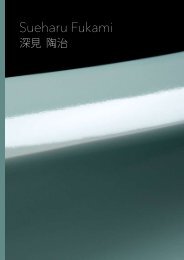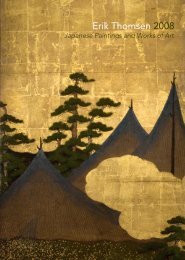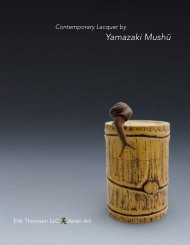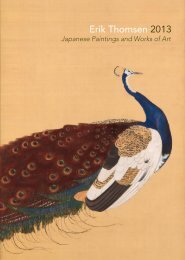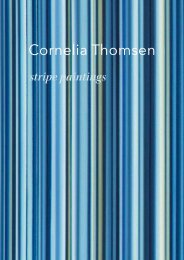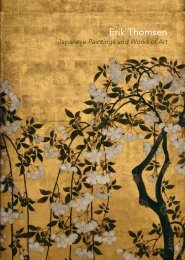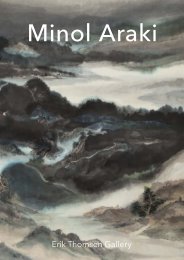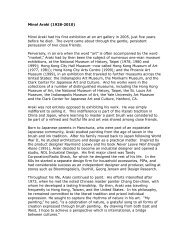View publication (pdf file 6.5 mb) - Erik Thomsen
View publication (pdf file 6.5 mb) - Erik Thomsen
View publication (pdf file 6.5 mb) - Erik Thomsen
- No tags were found...
You also want an ePaper? Increase the reach of your titles
YUMPU automatically turns print PDFs into web optimized ePapers that Google loves.
24Morita Chikuami森 田 竹 阿 弥 (1877 –1947)Flared Flower Basket 末 広 形 花 籃Shōwa Period (1926 – 89), 1930sH 19", D 10 ¼"(48.5 cm, 26 cm)Ikebana flower basketHōbichiku smoked ba<strong>mb</strong>oo and rattanIncised signature on the bottom:Chikuami kore tsukuru »Chikuami made this«Box inscription, outside:Suehiro gata hanakago »Flared Flower Basket«Box inscription, inside:Chikuami zō »Made by Chikuami«with a round red seal mark reading Chikuami.Collector’s label on the box reads Takekagohanaike or »Ba<strong>mb</strong>oo Basket Flower Vessel«a warm patina over time. To add to an aged, rusticlook, sabi or charcoal powder was dusted onto thesurfaces and then only partially brushed away, remainingin corners and cracks. The body is plaitedin an irregular ajiro ami or twill pattern and alongthe vertical ba<strong>mb</strong>oo strips and the handle are fancyknots made with rattan.The basket is square on the bottom, flaring out toa larger round opening. This suehiro or flaring shapeis auspicious in Japan, as it sy<strong>mb</strong>olizes growth andimprovement, starting small and growing in size.On the bottom edge is the artist’s finely incisedsignature. The basket is complete with the originalotoshi ba<strong>mb</strong>oo tube to hold the flowers and waterand the original fitted tomobako box.This basket in the Japanese taste was made to lookrustic, using old hōbichiku smoked ba<strong>mb</strong>oo andincluding knobbed node sections in the design.After plaiting, the outer surfaces were lacqueredwith a red-brown natural lacquer that has acquiredChikuami is the artist name of Morita Shintarō, whowas active in Kyoto in the early Shōwa period. Forthis basket in the Japanese style (as opposed to thekaramono Chinese style) he used Hōbichiku ba<strong>mb</strong>oo,which is a smoked ba<strong>mb</strong>oo traditionally used in farmhouse ceilings. They can be hundreds of years oldand have gained a warm rich-colored patina fromage and from hearth smoke.For another basket by Chikuami in the karamonoChinese style, see our 2006 <strong>publication</strong>, item 13.86 87



